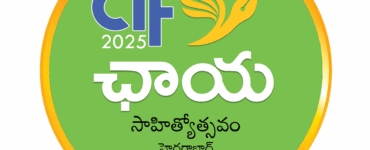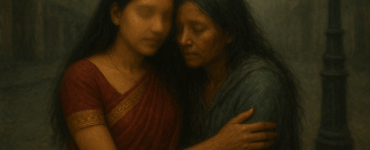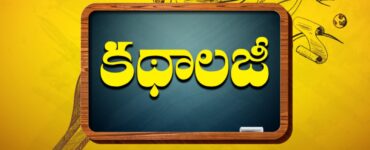Dr. Bharathi, who writes as Githanjali is a writer, doctor, woman sexologist and a member of virasam (revolutionary writers association). She published a novel Ame Adavini Jayinchindi in 1998, a collection of short stories Bachhedaani in 2003, a collection of writings Palamuru Bathuku Chitralu in 2014. Githanjali says that Mahashwetha Devi is her inspiration and model in her activism and writings. Her writings reflect her ideology and social commitment. Most of her writings are centred around gender questions. Her novel traces the trajectory of a woman doctor who ventures to question and defy the institutions that bind a woman. She declares that the novel was based on her life. Her short story collections Pehechan and Bachhedaani hold a mirror to the different identities and dimensions of women’s lives from childhood to old age. Muslim womanhood is also presented with a keen observation. Her concern for the migrating workers from Palamuru and anger about the Polepalli SEZ are reflected in her Palamuru Bathuku Chitralu. As she has said in one of her interviews, she is not owned by Telangana writers as she has Andhra origins and she is not owned by the Andhra writers as she writes in Telangana Telugu. Similarly, she has also faced opposition from the minority writers for writing about Muslim women being a non-Muslim woman herself. She understands and also problematizes her location in her writings.
The stories included in this translated volume are only a sample of Githanjali’s work on women’s issues in the given context. The writer touches upon issues that are not generally talked about or that are talked about differently from a male/patriarchal perspective. She tries to re-define not only the day to day issues in a woman’s life but also the so-called definitions given by the medical field, especially psychiatry. One can understand how women are labelled, isolated and stigmatised. Her writings can significantly contribute to the sexuality studies and disability studies from a feminist perspective.
We are reminded of Mary Day’s feminist analysis of the evolution of medical science and the inherent hatred and scare for women’s bodies and women’s knowledge systems. Mary Daly in her book Gyn/Ecology talks about gynaecology of body and gynaecology of mind, that is gynaecology and psychiatry, both of which acquire an anti-woman attitude in understanding her and telling her that the science knows better about her body and mind and not her. Patriarchy assumes the guise of scientific status and becomes much more hegemonic and discriminating. Any woman who protests or reveals her knowledge is branded as a witch thus leading to not only distancing her but also punishing her.
Githanjali’s stories teach us how to look into the hidden reasons behind a woman’s uninterestedness rather scare for sex which is “scientifically” described as frigidity. It is the sexual violence, assault, humiliation, betrayal that transform into hatred for sex. Such uninterestedness can easily be attributed to a woman’s “other” sexual interests/relations, and her conduct becomes a suspect. A woman, in a patriarchal society, has to be sexually passive but has to be passively active for the man who has acquired the authority over her through marriage. On the other hand, a woman’s sexuality is also constantly under surveillance. Any trace of her sexually being active, whether it is for the reasons of emotional needs or the physical needs, can lead to her being blamed as a nymphomaniac longing for multiple sexual relationships and can be put on therapies to become normal. In all this, family, as well as the doctors, carry out the roles of the representatives of the patriarchal institutions.
It is not just passively active, but she also has to be desirable according to the man’s fancies and longings. The measurements are fixed by the commodifying institutions and are reiterated by the man. The “breasted experience” that Iris Marion Young speaks about, in her Throwing like a Girl goes a little further when Githanjali’s story discusses how the breast measurements can turn a woman’s life into an experiment. The silicon implants filled in a woman’s body to satisfy her man’s fancies result in breast cancer to which she succumbs.
The measurements are not confined to the appearance but also extend to the experience; that is a male experience. A woman is convinced to have an extra stitch, the husband stitch, to hold onto her husband who goes in search of his physical pleasures after childbirth. The trauma of being treated as breasts, like a vagina, as a womb, and as a “boxing bag” fills the lives of characters in Githanjali’s stories. She says that they were not characters but were the women who met her screaming out for help.
Remaining a mere womb, becoming a bachhedani and giving birth to children until she turns dead is a fact about many women’s lives in the given context. But, suffering from acute uterine problems and dreading to get her uterus removed fearing that her husband might refuse to lead a sexual life with a woman without a uterus and marry again is also part of this predicament that Githanjali presents. Such a depiction actually extends the discussions related to disability studies. On the one hand, women are considered as mere wombs and those who cannot give birth to children or male children, in particular, are not considered to be complete women. But, a woman with a large number of children fearing about losing her husband to another woman if she gets her uterus removed is another dimension where we perceive the man’s pretext getting attributed as a disability on the woman.
It is not a mere pathetic representation of women that we get to be introduced to in the world created by Githanjali. It is also the resistance, protest, and transformation that we get to be familiarised. The protest could be at the individual level or the collective level or the surrealistic level as well. One of the stories depicts a new born baby having a horn-like structure in place of her genitals as a defense mechanism. It suggests growing an alternative penis which is like a horn probably not violent like the male penis which turns into a weapon when it assaults women. Such a surrealist solution also symbolically suggests the anger that women have been suppressing in themselves against sexual violence.
My interest in feminist ideology and my roles as a teacher and a researcher made me render Githanjali’s short stories into English. It has been a traumatic experience, as a translator, to re-live the women’s haunting narratives. I believe this collection would be an enriching addition to the existing studies in feminist epistemology and women’s histories. Translation is a very effective strategy of intervention. I look at my effort of translating Githanjali’s select short stories as my intervention in the field of women’s/feminist studies.
Gayatri Chakravorty Spivak, a renowned feminist critic, and translator who is also known for her English translations of Mahashwetha Devi’s writings brings up a discussion about “translatese,” a language for translation which can carry the complexity of the original text. The women’s experience is the original text here, which is translated into their narratives and then into Githanjali’s short stories which is finally rendered into English. The experience is articulated at multiple levels and from multiple perspectives, and each level has its specific context and expression. Some of the stories in this collection have extensively used Urdu which is the language spoken by the Muslim women whose lives are depicted in these stories. My initial version of translations translated the lines/sentences into English but retained some Urdu words which were culturally loaded and could not be translated into English in all their complexity. However, the writer intervened to say that the strategy that she has used in her stories could be used in English translation as well. That is, to use the Urdu lines as they are, for they represent the religious, economic and regional location of the women, and give the meaning in English in brackets.
I followed the writer’s suggestion thus translating not only the text but also translating the strategies that the writer used to convert the experience into the written word. Interestingly, in the Telugu context, Urdu becomes the synonymous identity for Muslim while it is not so in English. Like the women’s experience that Githanjali’s stories depict adds to the feminist articulation in English, the linguistic strategy that she uses in her stories also adds to the discourse in English happening around not only gender and sexuality but also translation.
My first familiarity with her writings was in 1998 when I read her novel. I read it with amazement about her theme, her ideology, and her conclusions. It continued throughout my reading of her other work as well. I admire the way she chooses her themes. So, apart from being a teacher and a researcher, it is also as a reader that I ventured into translating her stories. I felt a compelling need to share my reading of Githanjali and my discovery of a feminist material with readers in English. I must acknowledge the enthusiasm with which Githanjali discussed her writings. Our long telephonic conversations have proved as inspiring as her writings have been for me.
*









The ability to bring the most subtle abstract emotion into a vivid representation in the form of a story is very difficult. It demands an equally poised strength to translate them or Estella them as I can understand. Kudos to Gitanjali and Suneetha Rani for the vast work and the consistency of it. Warm regards too.
Have I missed the title of the collection in English translation and publication details mentioned ?